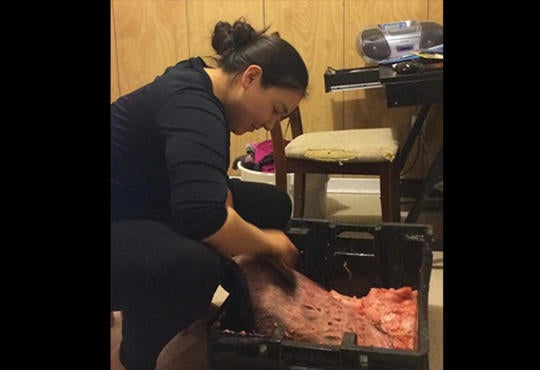 Charles Marzzacco and Charles Pepin
Charles Marzzacco and Charles Pepin
Heat flow and temperature control are important topics in chemistry and chemical engineering. In a recent paper in Chem 13 News1 one of us (CM) analyzed the cooling curve of hot water in an insulated cup as an example of a first-order process. Although not stated explicitly, it was assumed that the hot water in the cup loses heat to the surroundings according to a pure conduction model.2,3

Eq. 1
Where dQ/dt is the rate of heat flow out of the cup, κ is the thermal conductivity constant for the cup material, A is the surface area of the cup, d is the thickness of the cup wall and (T – TRoom) is the temperature difference between that of the water in the cup and that of the room.
The author (CM) of the original Chem 13 News article implicitly assumed that TRoom is the temperature of the outside surface of the cup when a pure conduction model was used. In hindsight, it should have been obvious to him that this was a mistake. This incorrect use of the pure conduction model was revealed in Charles Pepin’s (coauthor’s) science fair project. The outside surface of the cup is obviously hot or warm to the touch. Heat is not carried away fast enough from the cup to make the temperature of the outside surface of the cup equal to room temperature. Clearly, the cooling of the hot water in the cup involves conduction of heat through the cup followed by convection of the hot air associated with the outside surface of the cup away from the surface of the cup. Since the temperature of the outside surface of the cup, Toutside cup surface, is greater than the temperature of the room, TRoom, conduction through the cup wall will be much slower than the pure conduction model would predict. Since the gradient associated with the pure conduction model is much larger than the actual gradient, the pure conduction model will predict a much greater heat flow out of the cup than the actual experimental cooling curve would reveal.
In this paper, we use modeling and hypothesis testing to show that conduction followed by convection is the correct model for the cooling of a hot fluid in a cup. We will begin by showing that a pure conduction model predicts that hot water in an insulated cup will cool down much faster than what is experimentally found to be the case. We assume that the temperature of the water in the cup is T and that associated with the outside surface of the cup is TRoom, the temperature of the room. According to Fourier’s law of heat conduction,2,3 the rate of heat
flow out of the cup is equal to

Eq.2
In this equation, ΔQ is the amount of heat flowing out of the cup during a small time interval, Δt. We used one-minute time intervals in our model. Thus Δt = 1.00 minute = 60.0 seconds. In equation (2), A is the surface area of the cup, d is the thickness of the cup wall and cover, m is the mass of liquid in the cup, C is the specific heat capacity of that liquid, and K is the thermal conductivity of the cup material. The thermal conductivity constant has units of joules second-1 meter-1oC-1. It is permissible to use oC rather than K since equation (2) involves temperature differences rather than absolute temperatures. Rearrangement of equation (2) yields:

Eq. 3
T is the temperature of the liquid in the cup, and TRoom is the temperature of the room. Again, it should be clear that the pure conduction model assumes that the outside surface of the cup is at room temperature. For simplicity, it will be assumed that A is the entire surface area of the cup. Most of the cup is in contact with the liquid in the cup, and heat leaks out of the cup from the air space above the liquid level as well as below the liquid level. Remember that there is a cover on the cup of the same material, so no cooling occurs due to evaporation. The base is not in contact with air, but we will assume heat is lost here at the same rate as through the walls and cover. This is certainly not the case, but the area is small, so the error is small.

The cups used in these experiments were medium-sized coffee cups from RaceTrac gas stations. They are made of polypropylene and are in the shape of a truncated cone. The surface area of the cup depends on the dimensions of the cup. See the figure right: the dimensions are r = 2.5 cm, R = 4.5 cm and S = 14.0 cm. The surface area of the cup, including the bottom, top and the sides is equal to:

Eq. 4
For polypropylene, reference 4 gives a range of values between 0.10 and 0.22 joules second-1 meter-1oC-1. We used a value of 0.10 in our modeling calculation. Use of a higher value would predict an even faster cooling curve. The thickness of the cup wall (d) as measured using a micrometer is 1.50 mm or 1.50x10-3 meters.
In applying equation (3) one must be careful about using the correct units. Since mC has units of J oC-1, m can be expressed in grams as long as C is expressed in J g-1oC-1. The surface area of the cup, A, should be expressed in meters2 and the thickness of the cup should be expressed in meters. An Excel spreadsheet calculation of the pure conduction model is available by e-mail request.5 For the case of 333 g of water in the polypropylene cup used in this experiment, the amount by which the temperature changes during each minute (60 seconds) of time can be shown to be:

Eq. 5
When the water in the cup is very hot, the temperature of the water in the cup drops much faster than when the temperature of the water in the cup is warm. Eventually the temperature of the water in the cup falls to room temperature, heat flow ceases and the temperature no longer changes. In order to obtain the pure conduction model cooling curve, the temperature change predicted by equation 5 is subtracted from the previous temperature. For example, for Tinitial = 90 oC and TRoom = 24 oC, in the first minute, the temperature decrease (ΔT) is, according to equation 5, -0.1125 minute-1 × 66 oC or -7.425 oC. So at the beginning of the second minute, the temperature is 82.575 oC. And so it goes.
The experimental cooling curve and the pure conduction modeling cooling curves are shown in Figure 1, curves A and C, respectively. As expected the hot water in the cup cools much more slowly than the pure conduction model predicts. The slower cooling is consistent with the conduction-convection model. The outside surface of the cup is not at room temperature. As a result, conduction through the wall of the cup is slower than the pure conduction model would predict. Following conduction through the cup wall, heat is carried away through convection of the hot air away from the outside surface of the cup.
If this analysis of heat flow in a coffee cup is correct, anything that would increase the convection of hot air away from the surface of the cup would increase the rate of heat flow and would cause the temperature of the water in the cup to drop more quickly. Thus, a hypothesis can be made that using a fan to blow room temperature air at the cup would cause the hot air associated with the surface of the cup to be carried away more quickly and would result in faster cooling of the hot water in the cup. Cooling curve B in Figure 1 shows this to be the case and is good evidence for the conduction-convection model of heat transfer.
In summary, this project presents an excellent example of using modeling and hypothesis testing to understand heat flow involving a hot fluid in a container. The pure conduction process is easy for the students to model and understand. Students should be able to come up with an alternative hypothesis in support of the conduction-convection interpretation. For example, what should happen to the cooling curve if the coffee cup containing hot water were immersed in a bucket of room temperature water? The high heat capacity of the water surrounding the cup would rapidly carry off the heat conducting through the wall of the cup. The outside surface of the cup would be maintained near room temperature. The resulting cooling curve would be similar to that of the pure conduction model. Students could perform an experiment to test if their hypothesis is correct.
 Figure 1. Cooling curves for 333 g of hot water in a polypropylene coffee cup
Figure 1. Cooling curves for 333 g of hot water in a polypropylene coffee cup
Notes and acknowledgement
The experimental cooling curves were obtained using a Vernier temperature probe and software (see reference 1).
Thanks to Lawrence Shacklette who pointed out the impact of convection in the cooling of hot liquid in a container.
References
- C. Marzzacco, “Cooling curves: a simple example of first-order analysis”, Chem 13 News, October 2008, pages 9-10.
[Contact us to get an electronic copy of this article] - Fourier’s Law of Heat Conduction, https://me-mechanicalengineering.com/fouriers-law/
- J. Walker, D. Halliday and R. Resnick, Fundamentals of Physics, 8th edition: John Wiley and Sons: United States, 2008, pages 493-494.
- www.engineeringtoolbox.com/thermal-conductivity-d_429.html
- cmarzzacco@aol.com







